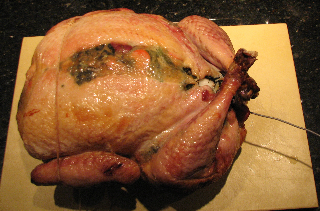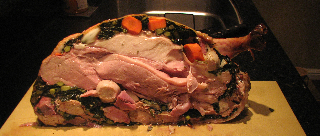Thanksgiving is plated comfort, dinner to honor a lore-steeped narrative of the harvest, funneled through a few hundred years of regional cultural variations. The foods are invariably soft, uncomplicated: balls of mush in warm hues -- orange, brown, beige, and dull, vegetal green -- a crust here, a relish there -- nothing to stun or overwhelm. An ambitious menu might boast edgy updates of accepted classics, but themes are very rarely abused or flaunted, merely tweaked: one might endeavor to make sweet potato casserole, for example, re-imagined as a single perfect fritter on each plate, sidling up to tidy blobs of marshmallow-esque creme fraiche, shaded by fronds of fried sage.
So long as the chile-garlic sauce stays in the fridge and no pretentious foams materialize, side dishes may be mussed in a respectful fashion. Turkey, whole, however, is a most traditional yet often maligned centerpiece -- flightless, frequently bone-dry, and hard to budge. Every year, food writers fall over themselves trying to convince desperate cooks they've found an antidote -- brining, larding, frantic temperature adjustments -- when they'd better serve suppers by pushing far superior animal proteins -- say, glorious hams, sides of wild salmon, or haunches of venison.
 Enter the turducken. Despite its cultish presence in the cozy Thanksgiving lexicon, the turducken is aggressively weird, an unnatural, misshapen, stitched-up Frankenstein-like thing -- something that perhaps resembled a "sneetch" in life -- prior to being butchered and baked. Still, as the steaming mass -- chicken, within duck, within turkey -- all boned and stuffed -- descends on an overloaded banquet table, accompanied by grand quasi-medieval pomp, hearty eaters think nothing of its artificial genus, gathering around to slice through and spill forth the intertwined meaty chunks in varied hues -- reveling in the surreal delicious guts of a very strange beast indeed.
Enter the turducken. Despite its cultish presence in the cozy Thanksgiving lexicon, the turducken is aggressively weird, an unnatural, misshapen, stitched-up Frankenstein-like thing -- something that perhaps resembled a "sneetch" in life -- prior to being butchered and baked. Still, as the steaming mass -- chicken, within duck, within turkey -- all boned and stuffed -- descends on an overloaded banquet table, accompanied by grand quasi-medieval pomp, hearty eaters think nothing of its artificial genus, gathering around to slice through and spill forth the intertwined meaty chunks in varied hues -- reveling in the surreal delicious guts of a very strange beast indeed.
For three years, I lived with a few turducken aficionados in a big house at the edge of the Mission District, close to Potrero Hill. They would stay up the entire night before Thanksgiving, boning and trussing. There were no good chef's knives in that house then, so strings of meat bounced dangerously around the room with every nip and tuck, and the kitchen floor eventually took on a fatty sheen from all the spills. We'd host big Thanksgivings too, with a long table to accommodate a mob of friends. There was always a lot to drink; the living room was always too dark; you usually couldn't even make out the color of what sat quivering on your fork -- that is, if you were sober enough to care by the time all the food was ready. I recall, on one boozy occasion, trying to separate out the excavated components of my turducken slice -- to appraise them each, and assess how their individual qualities affected the flavor of the opulent whole. At this, I failed.
Like most people who have studied up on the subject, I hold corpulent football personality John Madden responsible for the turducken's first wave of popularity. Until he had a change of heart in 2008, he used to gleefully dole out massive specimens to Thanksgiving Bowl victors. Bestowing credit for the preparation's actual invention, however, is a tougher proposition. Paul Prudhomme got a nod for a while, but his role -- attributed loosely to a 1983 appearance at a festival in Duvall, Washington -- has not been verified. In a November 2005 article in National Geographic, Calvin Trillin presented Herbert's Specialty Meats in Maurice, Louisiana as a long-running, immensely popular purveyor of pre-assembled 'duckens, but avoided making any claims about its involvement in the dish's origins.
 If, for you, after all that, mere turducken will still do come November 26th, you can savor it without shelling out for shipping or expending any effort beyond tending the oven. While supplies last, Ryan Farr of the esteemed
If, for you, after all that, mere turducken will still do come November 26th, you can savor it without shelling out for shipping or expending any effort beyond tending the oven. While supplies last, Ryan Farr of the esteemed